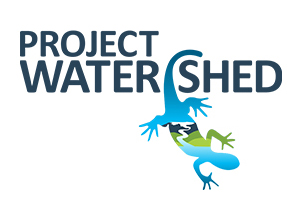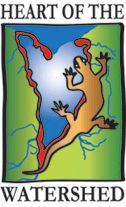 The K’ómoks Estuary is the gem in the crown of the Comox Valley and the Heart of our Watershed. Since 2008, we at Project Watershed have endeavored to protect and restore the K’ómoks Estuary to its former glory. We work with the Estuary Working Group, which is comprised of representatives from more than 12 other stewardship groups in the Valley, and are involved in a variety of projects from awareness raising, research, mapping, restoration, protection, to land acquisition. To guide this work, we chose a traditional aboriginal principle — Keeping it Living and added “the return of abundance” which comes from the name “Comox” (“K’ómoks”), which means “land of plenty or abundance.” With a mission to bring about the return of abundance, the Keeping It Living project is dedicated to the preservation of marshes, sloughs, mud flats, gravel beds, shore grasses, shrubs, forest, streams, rivers, and watersheds that provide nutrients to nourish estuary life. The Keeping It Living principle has also become the banner for our public outreach efforts which includes an artistic component; often in the form of an art competition and silent auction.
The K’ómoks Estuary is the gem in the crown of the Comox Valley and the Heart of our Watershed. Since 2008, we at Project Watershed have endeavored to protect and restore the K’ómoks Estuary to its former glory. We work with the Estuary Working Group, which is comprised of representatives from more than 12 other stewardship groups in the Valley, and are involved in a variety of projects from awareness raising, research, mapping, restoration, protection, to land acquisition. To guide this work, we chose a traditional aboriginal principle — Keeping it Living and added “the return of abundance” which comes from the name “Comox” (“K’ómoks”), which means “land of plenty or abundance.” With a mission to bring about the return of abundance, the Keeping It Living project is dedicated to the preservation of marshes, sloughs, mud flats, gravel beds, shore grasses, shrubs, forest, streams, rivers, and watersheds that provide nutrients to nourish estuary life. The Keeping It Living principle has also become the banner for our public outreach efforts which includes an artistic component; often in the form of an art competition and silent auction.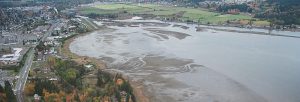 An estuary is the part of the wide lower course of a river where its current is met by the tides. Estuaries are where salt and fresh water meet. They are rare, extremely productive and important habitats making it imperative we restore and protect them to the best of our ability. They have biodiversity greater than tropical rainforests and sequester carbon at an estimated rate of about 90 times greater than forested sites of equal area. On the coast of British Columbia 80% of marine species use estuaries for some portion of their life cycle. Since they are where fresh and salt waters meet work in an estuary benefits both the fresh water and salt water environments and species.
An estuary is the part of the wide lower course of a river where its current is met by the tides. Estuaries are where salt and fresh water meet. They are rare, extremely productive and important habitats making it imperative we restore and protect them to the best of our ability. They have biodiversity greater than tropical rainforests and sequester carbon at an estimated rate of about 90 times greater than forested sites of equal area. On the coast of British Columbia 80% of marine species use estuaries for some portion of their life cycle. Since they are where fresh and salt waters meet work in an estuary benefits both the fresh water and salt water environments and species.
The K’ómoks Estuary (formerly the Courtenay River Estuary), second only in importance to the Fraser River Estuary, is a special and unique feature of the Comox Valley. It is one of only eight Class 1 estuaries in British Columbia and provides habitat for 145 bird species (more than 70,000 birds), 218 plant species, 29 fish species (including all five species of pacific salmon) and innumerable species of intertidal animals (clams, worms, bacteria, viruses, etc.). You can now visit and explore our new Interactive Estuary Map which contains all the data we have amassed on our estuary – our official launch will be in January 2016.
 Our restoration projects focus on creating habitats through land acquisition and blue carbon plantings as well as improving existing habitat. We are currently work
Our restoration projects focus on creating habitats through land acquisition and blue carbon plantings as well as improving existing habitat. We are currently work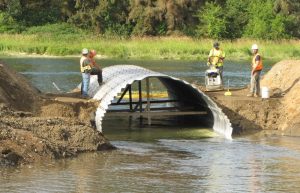 ing towards the acquisition and restoration of the Field Sawmill site which when restored is planned to provide a public walk way and interpretative signage as well as habitat, carbon sequestration and flood and storm surge mitigation (learn more). As part of our Blue Carbon initiative we are planting eelgrass, salt marsh and kelp. These plants provide habitat, sequester carbon, and also help mitigate against storm surges and erosion (learn more). We have also completed installing a culvert connecting the Courtenay River to the Air Park Lagoon. This culvert brings fresh, oxygen rich water into the lagoon making the lagoon better habitat and proving a through fare for marine species including salmon (learn more).
ing towards the acquisition and restoration of the Field Sawmill site which when restored is planned to provide a public walk way and interpretative signage as well as habitat, carbon sequestration and flood and storm surge mitigation (learn more). As part of our Blue Carbon initiative we are planting eelgrass, salt marsh and kelp. These plants provide habitat, sequester carbon, and also help mitigate against storm surges and erosion (learn more). We have also completed installing a culvert connecting the Courtenay River to the Air Park Lagoon. This culvert brings fresh, oxygen rich water into the lagoon making the lagoon better habitat and proving a through fare for marine species including salmon (learn more).
Another reason the K’ómoks Estuary is special is the vast number of well preserved wooden stakes that make up ancient fish traps.  Nancy Greene and David McGee, who have been studying these stakes for many years, estimate that there are over 150,000 of them pounded into the sediment. From their work we know that a large aboriginal trap fishery was maintained in the estuary for well over 1,000 years (Nancy and David have carbon dated one stake to be around 1400 years before present) without depleting the fish resources or habitat. This is the type of abundance we wish to return to and this year we are
Nancy Greene and David McGee, who have been studying these stakes for many years, estimate that there are over 150,000 of them pounded into the sediment. From their work we know that a large aboriginal trap fishery was maintained in the estuary for well over 1,000 years (Nancy and David have carbon dated one stake to be around 1400 years before present) without depleting the fish resources or habitat. This is the type of abundance we wish to return to and this year we are 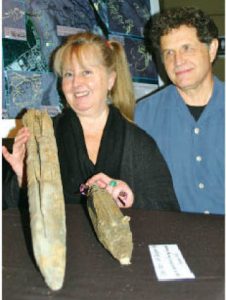 celebrating Nancy and David’s work which is appearing in The Canadian Journal Of Archaeology (Volume 39 – Issue 2, December 2015). Nancy and David’s work will form the basis of a bid for National Historic Status which we will be assisting the Comox Valley National Historic Status Bid Committee in developing in the coming years.
celebrating Nancy and David’s work which is appearing in The Canadian Journal Of Archaeology (Volume 39 – Issue 2, December 2015). Nancy and David’s work will form the basis of a bid for National Historic Status which we will be assisting the Comox Valley National Historic Status Bid Committee in developing in the coming years.
The K’ómoks Estuary has been severely impacted over the years by industrial activity and changes are required if the estuary’s natural features are to be preserved. The estuary is also geographically divided into many distinct political jurisdictions and we are working with each jurisdiction individually towards it’s protection and restoration. It is our hope that one day a central body with representatives or delegates from all stakeholders will manage and govern the K’ómoks Esturay in an integrated manner – a step towards this is the K’ómoks Estuary Management Plan which is currently being revised by the K’ómoks First Nations.
Click here to learn more about estuaries and how they are formed.
A heron waiting motionless for a small fish, eagles soaring overhead emitting their piercing cry, the beating of wings as swans sweep low over the river and rise to clear the trees at the water’s edge, sandpipers darting here and there on the mud flats – their long beaks seeking small crustaceans buried in the mud, birds and frogs inhabiting the sloughs, salt marshes, and near shore producing a cacophony of sound that announces their presence and the renewal of life, salmon massing at the river mouth before moving up stream to spawn – this we hear, see, and experience in the Courtenay River Estuary. This is the ecological treasure that we are called on to conserve and protect.
An art & literature awareness & fundraising campaign to give everyone the opportunity to contribute to the preservation and restoration of the K’ómoks Estuary. Our 2015 campaign will be centered around the theme – Then, Now and Future – to inspire artists to capture their version of the past, present and future of the estuary…or all three! Nationally renowned First Nations artist Andy Everson has created a unique image for this years’ campaign. Join Andy in celebrating our one-of-a-kind estuary in 2015.


Keeping it Living 2015 Sponsorship Artwork
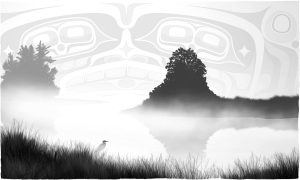 Stillness
Stillness
Andy Everson
Internationally Renowned Northwest Coast Artist
The print is of the estuary looking from the Rotary stand towards where the LaFarge tower use to be. At the top there is a First Nations representation of the Orion star constellation (according to legend the ” dipper cup contains fog which is emptied on a foggy day).
Living Waters
[/av_textblock]
[av_image src=’https://projectwatershed.ca/wp-content/uploads/2013/11/Living-Waters_web.jpg’ attachment=’3725′ align=’center’ animation=’no-animation’ link=” target=”]
[av_tab_container position=’top_tab’ boxed=’border_tabs’ initial=”]
[av_tab title=’Artwork Information’ icon_select=’no’ icon=’ue800′ font=’entypo-fontello’]
Artist: Martha Ponting
Medium: Acrylic on Canvas
Original Size: 20×20
Print Size: 14×14
[/av_tab]
[/av_tab_container]
[/av_one_fifth][av_one_fifth min_height=” vertical_alignment=” space=” custom_margin=” margin=’0px’ padding=’0px’ border=” border_color=” radius=’0px’ background_color=” src=” background_position=’top left’ background_repeat=’no-repeat’]
[av_textblock size=” font_color=” color=”]
Blue Forest
[/av_textblock]
[av_image src=’https://projectwatershed.ca/wp-content/uploads/2014/01/sdickie2012_2light.jpg’ attachment=’3846′ align=’center’ animation=’no-animation’ link=” target=”]
[av_tab_container position=’top_tab’ boxed=’border_tabs’ initial=”]
[av_tab title=’Artwork Information’ icon_select=’no’ icon=’ue800′ font=’entypo-fontello’]
Artist: Shirley Dickie
Medium: Acrylic on Canvas
Original Size: 40×40
Print Size: 15×15
[/av_tab]
[/av_tab_container]
[/av_one_fifth][av_one_fifth min_height=” vertical_alignment=” space=” custom_margin=” margin=’0px’ padding=’0px’ border=” border_color=” radius=’0px’ background_color=” src=” background_position=’top left’ background_repeat=’no-repeat’]
[av_textblock size=” font_color=” color=”]
Morning Mist
[/av_textblock]
[av_image src=’https://projectwatershed.ca/wp-content/uploads/2014/01/dyke-road-fog-w.jpg’ attachment=’3847′ align=’center’ animation=’no-animation’ link=” target=”]
[av_tab_container position=’top_tab’ boxed=’border_tabs’ initial=”]
[av_tab title=’Artwork Information’ icon_select=’no’ icon=’ue800′ font=’entypo-fontello’]
Artist: Rena Rogers
Medium: Photograph
Original Size: 11×16
Print Size: 11×16
[/av_tab]
[/av_tab_container]
[/av_one_fifth][av_one_fifth min_height=” vertical_alignment=” space=” custom_margin=” margin=’0px’ padding=’0px’ border=” border_color=” radius=’0px’ background_color=” src=” background_position=’top left’ background_repeat=’no-repeat’]
[av_textblock size=” font_color=” color=”]
Mingling Waters
[/av_textblock]
[av_image src=’https://projectwatershed.ca/wp-content/uploads/2011/01/68-Mingling-Waters-JW-web.jpg’ attachment=’886′ align=’center’ animation=’no-animation’ link=” target=”]
[av_tab_container position=’top_tab’ boxed=’border_tabs’ initial=”]
[av_tab title=’Artwork Information’ icon_select=’no’ icon=’ue800′ font=’entypo-fontello’]
Artist: Jennifer Weber
Medium: Oil
Original Size: 18×24
Print Size: 14×18
[/av_tab]
[/av_tab_container]
[/av_one_fifth][av_one_fifth min_height=” vertical_alignment=” space=” custom_margin=” margin=’0px’ padding=’0px’ border=” border_color=” radius=’0px’ background_color=” src=” background_position=’top left’ background_repeat=’no-repeat’]
[av_textblock size=” font_color=” color=”]
View from the Courtenay Airpark #34
[/av_textblock]
[av_image src=’https://projectwatershed.ca/wp-content/uploads/2013/11/View+From+Airpark.jpg’ attachment=’3728′ align=’center’ animation=’no-animation’ link=” target=”]
[av_tab_container position=’top_tab’ boxed=’border_tabs’ initial=”]
[av_tab title=’Artwork Information’ icon_select=’no’ icon=’ue800′ font=’entypo-fontello’]
Artist: Bev Byerley
Medium: Acrylic on Canvas
Original Size: 36×24
Print Size: 11×15
[/av_tab]
[/av_tab_container]
[/av_one_fifth][av_textblock size=” font_color=” color=”]
[/av_textblock]
[av_heading tag=’h2′ padding=’10’ heading=’Estuary and Economy’ color=’meta-heading’ style=” custom_font=” size=” subheading_active=” subheading_size=” custom_class=”][/av_heading]
[av_tab_container position=’sidebar_tab sidebar_tab_right’ boxed=’noborder_tabs’ initial=’1′]
[av_tab title=’Property Values & KEMP’ icon_select=’yes’ icon=’ue827′ font=’entypo-fontello’]
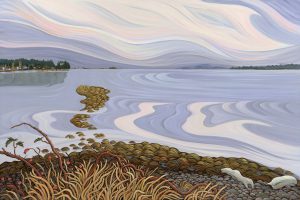 Protecting the estuary not only makes sense environmentally but also economically. Bev Byerley’s painting speaks to the quality of life we enjoy in the Comox Valley. Economists use property values among others to capture this value financially. The Estuary Working Group has produced a vision document and is working on a K’omoks Estuary Management Plan (KEMP) under the lead of the the Regional District and K’omoks First Nation to help sustain that quality of life and uphold those economic values. We hope to have this plan adopted by all federal, provincial and municipal governments.
Protecting the estuary not only makes sense environmentally but also economically. Bev Byerley’s painting speaks to the quality of life we enjoy in the Comox Valley. Economists use property values among others to capture this value financially. The Estuary Working Group has produced a vision document and is working on a K’omoks Estuary Management Plan (KEMP) under the lead of the the Regional District and K’omoks First Nation to help sustain that quality of life and uphold those economic values. We hope to have this plan adopted by all federal, provincial and municipal governments.
“Before there was pavement and the official designation as a walk path, my husband and I have walking around the Estuary almost every morning since moving to Courtenay. Inspired by the views, I did my first Airpark painting almost 20 years ago, now I am nearing my one hundredth and still just as inspired and grateful to live in such a beautiful place!” Bev Byerley
[/av_tab]
[av_tab title=’Fisheries/Aquaculture & Habitat Restoration’ icon_select=’yes’ icon=’ue827′ font=’entypo-fontello’]
 The K’omoks Estuary has been providing the Comox Valley with economic prosperity for thousands of years. Jennifer Weber’s painting speaks to the mingling fresh and salt waters of the estuary as well the diverse range of habitats necessary to support the abundance of fish and shellfish that provide food, livelihood, and sport fishing to region. In BC seafood commodities bring in over $1.4 billion and sport fishing generates over $288 million. Tyee salmon, once abundant here, are now seldom found in the area as habitat has been lost or damaged. Restoration projects aim to reverse this trend of habitat loss thus increasing the productivity and economic prosperity of our region. More valuing our oceans facts and figures below!
The K’omoks Estuary has been providing the Comox Valley with economic prosperity for thousands of years. Jennifer Weber’s painting speaks to the mingling fresh and salt waters of the estuary as well the diverse range of habitats necessary to support the abundance of fish and shellfish that provide food, livelihood, and sport fishing to region. In BC seafood commodities bring in over $1.4 billion and sport fishing generates over $288 million. Tyee salmon, once abundant here, are now seldom found in the area as habitat has been lost or damaged. Restoration projects aim to reverse this trend of habitat loss thus increasing the productivity and economic prosperity of our region. More valuing our oceans facts and figures below!
“Having driven the dyke road many times, I had already come to appreciate the beauty of the Estuary however I didn’t know what an estuary was. Getting a definition was a natural first step in proceeding with my submission and helped me to understand the greater importance of its survival. ‘Mingling Waters’ allowed me to immerse myself in the thought that 80% of all coastal species depend on the healthy state of our estuaries…absolutely astounding.” Jennifer Weber
The following are facts from reports done for the Province of BC on the contribution our ocean makes to our economy. There are arranged by year and include links to the full reports on the Province of BC website.
2011
- British Columbia offered 476 distinct fish and seafood commodities with a combined wholesale value of $1.4 billion.
- Salmon products generated 53% of the total wholesale value of all B.C. seafood.
- http://www.env.gov.bc.ca/omfd/reports/Seafood-YIR-2011.pdf
2010 Highlights
- Sport Fishing – A major tourist attraction for both domestic and foreign tourism markets – the sector supports about 7,700 jobs. Sport fishing generates $288 million a year in GDP.
- Capture fishing – The landed value from all species was 330 million. They constitute the fourth largest primary industry in British Columbia after forestry, mining and agriculture.
- Seafood – Products were exported to more than 74 countries and generated a total export value of $957 million.
- Aquaculture – produced 90,600 tonnes of fish and shellfish and generated $533.8 million in farmgate value.
- Total = $2.1 billion
- http://www.env.gov.bc.ca/omfd/fishstats/index.html
2007 Study
- From the analysis, it appears that the ocean economy is much larger than previously thought – with total output almost double an earlier estimate. As well, the ocean sector is broader and more diversified than indicated by previous findings.
- We also know little of the non-market values of our ocean – for example, cultural and spiritual benefits and the ocean’s value as a carbon sink.
- http://www.env.gov.bc.ca/omfd/reports/BCs-Ocean-Economy.pdf
2005 Study
- The total direct, indirect supplier plus induced consumer spending economic impacts of the ocean sector in 2005 were:
- $11.1 billion in GDP
- $7.6 billion in Labour Income i.e., wages & benefits
- 167,800 person-years of employment
- http://www.env.gov.bc.ca/omfd/reports/oceansector-economics.pdf
[/av_tab]
[av_tab title=’Agriculture & Archeology’ icon_select=’yes’ icon=’ue827′ font=’entypo-fontello’]
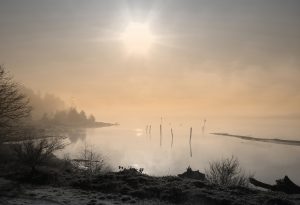 From the past and into the future the K’ómoks Estuary supports the economy of the Comox Valley. Rena Roger’s photograph captures a moment for us to reflect on this. Archeological work suggests a substantial First Nation community existed on the shores of the Estuary for over 1400 years. This community relied on the productivity from the land around the Estuary as well as the water as natural estuarine dynamics creates rich farmland. This farmland is still used today and remnant First Nation stakes bespeckle the mudflats supporting agriculture, agri-tourism and potentially archaeo-tourism. Project Watershed is committed to develop a bid for National Historic Status and the protection, education and tourism that could accompany this.
From the past and into the future the K’ómoks Estuary supports the economy of the Comox Valley. Rena Roger’s photograph captures a moment for us to reflect on this. Archeological work suggests a substantial First Nation community existed on the shores of the Estuary for over 1400 years. This community relied on the productivity from the land around the Estuary as well as the water as natural estuarine dynamics creates rich farmland. This farmland is still used today and remnant First Nation stakes bespeckle the mudflats supporting agriculture, agri-tourism and potentially archaeo-tourism. Project Watershed is committed to develop a bid for National Historic Status and the protection, education and tourism that could accompany this.
“I moved to the Comox Valley with my husband and children in 1994 and have been capturing the unique and awe inspiring natural wonders of the Comox Valley ever since. The Estuary is one such place and it has been the subject of many of my pieces.” Rena Rogers
[/av_tab]
[av_tab title=’Carbon Credits & Blue Carbon’ icon_select=’yes’ icon=’ue827′ font=’entypo-fontello’]
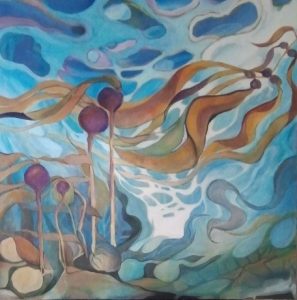 The K’ómoks Estuary offers economic possibilities that are just being discovered. In this respect Shirley Dickie’s painting is not only captivating but timely. Marine plants sequester carbon at rates higher than forests. In our Estuary these plants are eelgrass and those associated with salt marshes. Project Watershed is working with local, national and international groups to re-establish these plants and to capitalize on their carbon sequestration. This is a triple win as it increases habitat, provides shoreline resilience and removes CO2 from the atmosphere. Locally our governments spend thousands on carbon taxes; carbon credits in contrast would be an income source. The World Bank estimated the size of the global carbon credit market to be 64 billion in 2007.
The K’ómoks Estuary offers economic possibilities that are just being discovered. In this respect Shirley Dickie’s painting is not only captivating but timely. Marine plants sequester carbon at rates higher than forests. In our Estuary these plants are eelgrass and those associated with salt marshes. Project Watershed is working with local, national and international groups to re-establish these plants and to capitalize on their carbon sequestration. This is a triple win as it increases habitat, provides shoreline resilience and removes CO2 from the atmosphere. Locally our governments spend thousands on carbon taxes; carbon credits in contrast would be an income source. The World Bank estimated the size of the global carbon credit market to be 64 billion in 2007.
“For the “Blue Forest” painting I had to do some research on estuary systems and how they are preserved and restored. I found that eelgrass and kelp bed restoration play an important part in this sensitive ecosystem. Their “ecosystem service” role in providing habitat, shoreline protection and nutrition to hundreds of species is extremely important. Also during my research I found the scenes of underwater kelp beds extraordinarily beautiful. I was inspired by nature’s design and interpreted the images of floating kelp as emotional gestures of hope, flow and growth” Shirley Dickie
[/av_tab]
[av_tab title=’Tourism/Recreation/Research & Estuary Map’ icon_select=’yes’ icon=’ue827′ font=’entypo-fontello’]
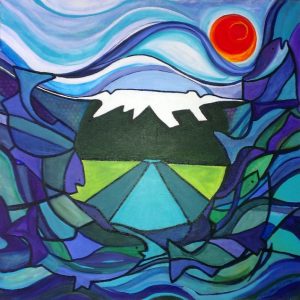
[/av_tab]
[/av_tab_container]
[av_textblock size=” font_color=” color=”]
[/av_textblock]
[av_textblock size=” font_color=” color=”]
[av_font_icon color=”” font=”entypo-fontello” icon=”ue8b9″ size=”40px” position=”left” link=”” linktarget=””] Project Watershed has been conducting the Keeping It Living Campaign to raise awareness and funds for the protection and restoration of the K’omoks Estuary since 2009.
[/av_textblock]
[av_heading heading=’Art submitted to Keeping It Living 2015′ tag=’h2′ style=” size=” subheading_active=” subheading_size=’10’ padding=’10’ color=’meta-heading’ custom_font=”][/av_heading]
[av_masonry_gallery ids=’4659,4658,4661,4660,4805,4804,4815,4816,4822,4823,4840,4845,4865,4866,4867,4868,4871,4874,4875,4946,4949,4967,4968,4990,5029,5027,5103,5104,5105,5111,5112,5113,5118,5119,5131,5132,5180,5181,5205,5207,5294,5208,5209,5218,5219,5223,5232,5233,5234,5235,5250,5249,5248,5247,5257,5258,5259,5260,5261,5283,5284′ items=’65’ columns=’3′ paginate=’none’ size=’flex’ gap=’large’ overlay_fx=” caption_elements=’title’ caption_display=’on-hover’ container_links=’active’ id=”]
[av_textblock size=” font_color=” color=”]
2009 – 2010

